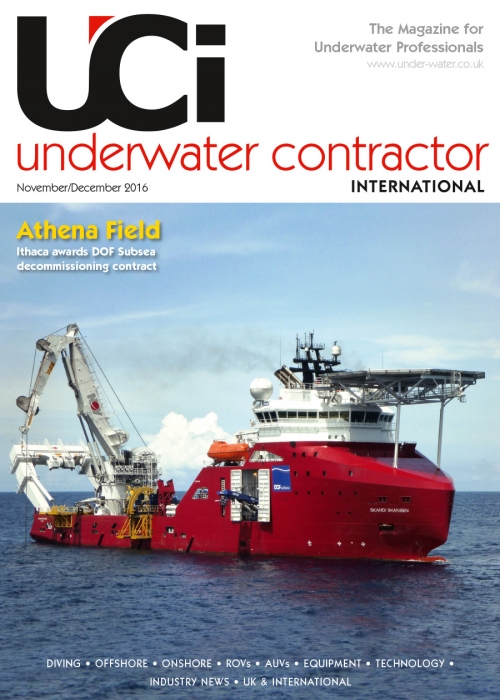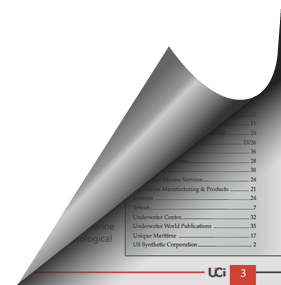
The Magazine for Underwater Professionals
![]() Sep/Oct 2015
Sep/Oct 2015
INDUSTRY NEWS - OPERATIONS
Harkand achieves two survey firsts in Mexico
UK-headquartered Harkand reports it has successfully carried out the first-ever free inertial metrology in Mexico’s waters and at a new depth for this approach in the region.
The inspection, repair and maintenance company achieved the survey results for its client at a depth of 380 feet (116 metres) in the Bay of Campeche, setting a new record in the area.
The scope of work saw Harkand working in collaboration with its metrology technology partner Zupt, USA, to complete the survey project in support of the installation of an expansion spool piece for a new pipeline and platform campaign in Mexico.
AJ Jain, Harkand managing director North America and Africa, said: “Our client wanted to know if the inertial metrology would better suit the project over the acoustic method.
“Our personnel are experienced in both techniques so after reviewing the work we were able to determine the free inertial metrology was the most time-saving and cost effective solution in this circumstance.
“Although a diver had not performed inertial metrology in this water depth before, we were confident in our saturation diving team’s experience and capabilities. Our client had the results in just 12 hours allowing the expansion spool piece design and fabrication to proceed very quickly. In comparison, the acoustic method would have taken three days to be reported back.”
SPOOL
The expansion spool piece was fabricated on board the vessel in two days, with the Harkand saturation diving team successfully installing the spool piece without any issues.
Jain added: “Our mission is to deliver the most efficient solution and the most accurate results for our clients. In subsea survey, project planning is essential. It’s key to consider all the factors including the environmental and project specific ones before proposing the best method of metrology.
“Being the first global company to complete this type of survey successfully in the region and by a diver at this depth is a really great start for our new office in Mexico. It not only showcases our in-house knowledge, skill and the expertise of our personnel, but our excellent assets combined with Zupt’s technology.”
Keith Vickery, Zupt president, said: “Inertial metrology is a mature product and has been used for over eight years worldwide with great success. Harkand has fully embraced the advantages and benefits of inertial technology and is bringing it to their clients with true value addition; their clients are seeing new and improved ways of doing old tasks, and with reduced project costs and improved project schedules.”
UK seabed survey company Bibby HydroMap has completed survey operations on the 30 million euro (£22 million) Deep Green marine energy project based off Holyhead, Wales, for consultant Xodus Group, UK, on behalf of developer Minesto AB, Sweden.
The objective of the survey was to provide a detailed understanding of the seabed levels, characteristics and shallow geology throughout the proposed development area and associated export cable route corridor, as well as to conduct an environmental baseline study. Bathymetric, sidescan sonar and sub-bottom profiler data was acquired alongside benthic grab samples and drop down camera stills on board Bibby HydroMap’s 26-metre survey vessel Chartwell.
Bibby HydroMap project manager Michael King said: “Bibby HydroMap are committed to providing high-quality results in challenging conditions, and the opportunity to work on this site has allowed us to do just that. We are looking forward to seeing how this project develops, and we hope to be able to provide further support in the coming years as Deep Green comes online.”
FOCUS
With a focus on efficiency and cost reduction, the revolutionary Deep Green project, which is supported by EU funds of 13 million euros (£9.5 million) through the Welsh government, is designed to maximise electricity generation from low velocity tidal currents. The kite-influenced design enables the device to move through the water column ten times faster than the current, which leads to a 1000 times more power as a result of the cubic relationship between speed and power.
Following the success of the first 0.5-megawatt installation, the aim is to deploy a ten-megawatt Deep Green array in Holyhead Deep which will supply electricity to the equivalent of 8000 households.
UK-based ASV reports it has collaborated with the Littoral Acoustic Demonstration Center Gulf Ecological Monitoring and Modeling (LADC-GEMM), USA, consortium to conduct ten days of passive acoustic monitoring (PAM) data collection for its BP/Gulf of Mexico Research Initiative (GoMRI) funded project.
An ASV spokesman said that the company worked closely with Seiche Measurements, UK, to integrate its PAM technology on both the C-Worker 6 and C-Enduro autonomous surface vehicles. “The ASV crew operated from the RV Pelican coastal research vessel to collect extensive data, which will undergo analysis in the coming months,” he said.
The C-Worker 6 and C-Enduro were able to identify approximately 30 marine mammals whilst operating in challenging sea conditions up to sea state 5, according to the spokesman.
Passive acoustic monitoring is increasingly used by the scientific community to study, survey and census marine mammals, especially cetaceans. The three-year BP/GoMRI sponsored project intends to investigate how the 2010 Deep Water Horizon oil spill has affected marine mammal populations in nearby spill areas, as well as improve methods for monitoring everyday operations in the Gulf of Mexico.


